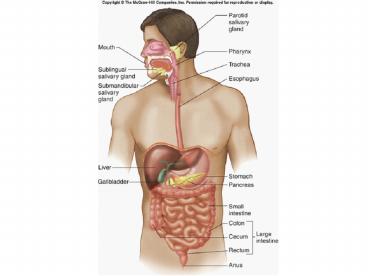The major function of the GI system is absorption of nutrients. . - PowerPoint PPT Presentation
1 / 21
Title:
The major function of the GI system is absorption of nutrients. .
Description:
The major function of the GI system is absorption of nutrients. . The GI tract is not a major site of waste product excretion. Fecal material is mostly bacteria that ... – PowerPoint PPT presentation
Number of Views:141
Avg rating:3.0/5.0
Title: The major function of the GI system is absorption of nutrients. .
1
(No Transcript)
2
The major function of the GI system is absorption
of nutrients..
The surface area of the intestine is 300 m3.
Intestinal villi maximize surface area ?
https//eapbiofield.wikispaces.com/DigestiveSyste
mWilson
3
The GI tract is not a major site of waste product
excretion.
- Fecal material is mostly bacteria that never
actually enter the body. - Major waste products excreted throough the GI
tract - Bilirubin a breakdown product of hemoglobin
- Cholesterol
4
Major GI Processes
5
(No Transcript)
6
(No Transcript)
7
Major GI Hormones
- Gastrin stimulates acid secretion and motility
of stomach - Secretin inhibits acid secretion and motility
of stomach i.e. slows gastric emptying, in
response to acid in small intestine - Cholecystokinin (CCK) also inhibits acid
secretion and motility of stomach, but in
response to amino acids and fatty acids in small
intestine. - Glucose-dependent insulinotropic peptide (GIP)
stimulates insulin release in response to glucose
and fat in small intestine.
8
(No Transcript)
9
http//www.uoflhealthcare.org/digestivehealth/gerd
.htm
10
http//www.merck.com/media/mmhe2/figures/fg123_1.g
if
11
Barretts Esophagus
http//www.barrettsinfo.com/figures/fig3a_4.jpg
12
http//jama.ama-assn.org/cgi/content/full/294/15/1
986
13
(No Transcript)
14
Carbohydrate Digestion
The digestion of carbohydrate. The complex polysaccharide starch is broken down into glucose by the enzymes amylase and maltase (secreted by the small intestine).(Image RM)
http//media.tiscali.co.uk/images/feeds/hutchinson
/ency/thumbs/0013n025.jpg
15
Protein Digestion
The digestion of protein. Protein is broken down into amino acids by the enzymes pepsin (secreted by the stomach) and trypsin and peptidase (in the small intestine).(Image RM)
http//media.tiscali.co.uk/images/feeds/hutchinson
/ency/thumbs/0013n023.jpg
16
Fat Digestion
The digestion of fat. Fat is broken down into fatty acids and glycerol by bile (secreted by the gall bladder) and the enzyme lipase (secreted by the small intestine).(Image RM)
http//media.tiscali.co.uk/images/feeds/hutchinson
/ency/thumbs/0013n024.jpg
17
(No Transcript)
18
Balance of GI inputs and outputs.
19
Iron absorption is altered in response to changes
in iron homeostasis.
Ferritin traps iron and holds it in cells. When
iron levels are low, you produce less
ferritin. When iron levels are high, you
produce more ferritin.
http//www.mfi.ku.dk/ppaulev/chapter22/images/22-1
6.jpg
20
Consequences of prolonged vomiting
- Dehydration
- Metabolic Alkalosis (due to loss of gastric acid)
- Low serum K (due to action of aldosterone,
which is released after prolonged dehydration). - Malnutrition
21
Cholera toxin increases the intracellular levels
of cAMP. This leads to an increase in chloride
secretion into the small intestine. Water
follows osmotically.
http//www.surrey.ac.uk/SBMS/ACADEMICS_homepage/mc
fadden_johnjoe/img/Cholera20toxin.jpg































